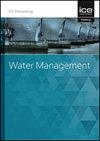Effect of sediment supply on flow characteristics in a meandering channel
IF 0.9
4区 工程技术
Q3 ENGINEERING, CIVIL
Proceedings of the Institution of Civil Engineers-Water Management
Pub Date : 2023-02-20
DOI:10.1680/jwama.22.00039
引用次数: 0
Abstract
Meandering channels widely exist in natural rivers, especially in lowland alluvial plains. In this research, a meandering channel is designed, in order to explore the effect of sediment supply on flow characteristics in it. In this channel, the water level, three-dimensional instantaneous velocity, and riverbed elevation are measured by digital wave altimeter, three-dimensional acoustic Doppler velocimeter (ADV) and three-dimensional laser scanner, respectively; and the flow characteristics with (first case) and without sediment (second case) supply are compared. The results showed that under the same discharge, the transversal slope of water surface in the first case is larger than the second case, and its change is steeper; the longitudinal change degree of water surface in the upper half bend is small, and that is large in the lower half bend. By increasing the water discharge, the number of secondary flow vortices at the apex of meandering channel is increased. The trend of the two mainstream lines, with and without sediment supply, are roughly opposite, and the difference between them decreases with increasing the discharge. In addition, the lateral and vertical turbulence intensity of the flow near the outer bank are larger under the two cases. The turbulent kinetic energy of the cross-section is larger in the first case near the bed and water surface.泥沙供给对曲流河道流动特性的影响
曲流河道广泛存在于天然河流中,特别是在低地冲积平原。本研究设计了一条曲流河道,探讨泥沙供给对曲流河道流动特性的影响。采用数字波高度计、三维声波多普勒测速仪(ADV)和三维激光扫描仪分别测量河道水位、三维瞬时流速和河床高程;并对有(第一种情况)和无(第二种情况)输沙时的水流特性进行了比较。结果表明:在相同流量下,第一种情况下的水面横向坡度大于第二种情况,其变化幅度更大;上半弯水面纵向变化程度小,下半弯水面纵向变化程度大。通过增加放水量,增加了曲流通道顶部二次流涡的数量。有输沙和无输沙两条干流的趋势大致相反,两者的差异随着流量的增加而减小。此外,在两种情况下,靠近外滩的流动的横向和垂直湍流强度都更大。在第一种情况下,靠近河床和水面的截面湍流动能较大。
本文章由计算机程序翻译,如有差异,请以英文原文为准。
求助全文
约1分钟内获得全文
求助全文
来源期刊
CiteScore
2.10
自引率
0.00%
发文量
28
审稿时长
6-12 weeks
期刊介绍:
Water Management publishes papers on all aspects of water treatment, water supply, river, wetland and catchment management, inland waterways and urban regeneration.
Topics covered: applied fluid dynamics and water (including supply, treatment and sewerage) and river engineering; together with the increasingly important fields of wetland and catchment management, groundwater and contaminated land, waterfront development and urban regeneration. The scope also covers hydroinformatics tools, risk and uncertainty methods, as well as environmental, social and economic issues relating to sustainable development.

 求助内容:
求助内容: 应助结果提醒方式:
应助结果提醒方式:


